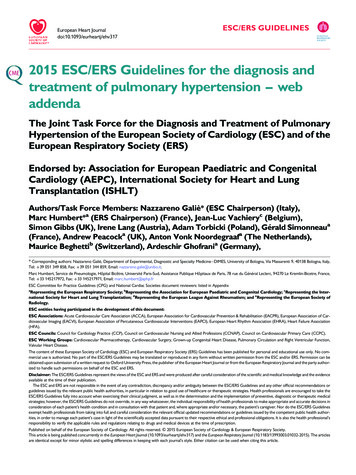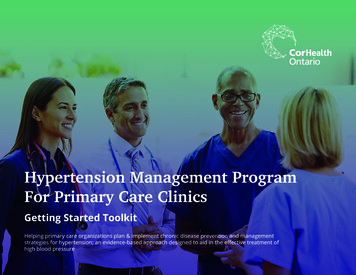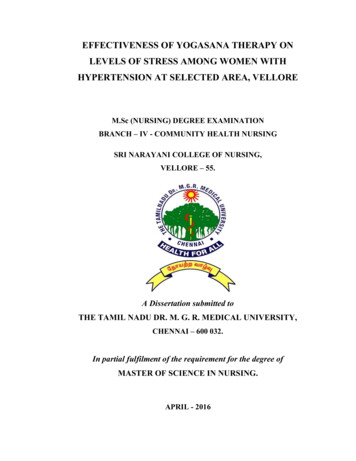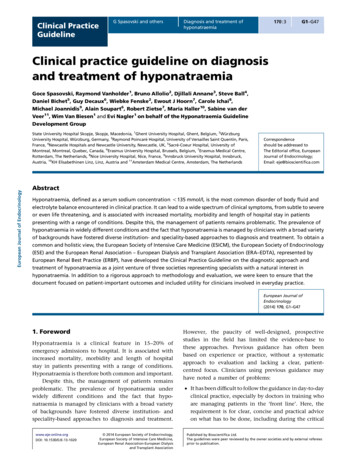
Transcription
Hypertension Diagnosis and Treatment GuidelineMajor Changes as of August 2014 . 2Preface . 3Exclusions . 3Prevention . 3Screening . 3Diagnosis. 4Treatment Goals . 5Initiating Treatment . 5Lifestyle Modifications . 6Pharmacologic Options . 7ASCVD Prevention .10Follow-up/Monitoring .10Evidence Summary .11References .15Guideline Development Process and Team .19Last guideline approval: August 2014Guidelines are systematically developed statements to assist patients and providers in choosingappropriate health care for specific clinical conditions. While guidelines are useful aids to assist providersin determining appropriate practices for many patients with specific clinical problems or prevention issues,guidelines are not meant to replace the clinical judgment of the individual provider or establish a standardof care. The recommendations contained in the guidelines may not be appropriate for use in allcircumstances. The inclusion of a recommendation in a guideline does not imply coverage. A decision toadopt any particular recommendation must be made by the provider in light of the circumstancespresented by the individual patient. 1999 Kaiser Foundation Health Plan of Washington. All rights reserved.1
Major Changes as of August 2014NewPreviousBlood pressure goalsThe blood pressure (BP) goal for the generalpopulation aged 80 or older has been raised to 150/90 mm Hg. The BP goal for the generalpopulation up to age 80 remains at 140/90 mm Hg. (Note: this is different fromthe JNC 8 panel guideline; see EvidenceSummary for rationale.)The BP goal for the general population was140/90 for patients of all ages.Diabetes and atherosclerotic cardiovasculardisease (ASCVD) patients no longer have alower BP goal than the general population. TheBP goal for these populations has been raisedto 140/90 mm Hg.The BP goal for patients with diabetes orASCVD was 140/80 mm Hg.There are now two separate BP goals forpatients with chronic kidney disease (CKD): 140/90 mm Hg for those without albuminuria,and 130/80 mm Hg for those withalbuminuria.The BP goal for all patients with CKD was 140/80 mm Hg.Drug treatment and monitoringDiuretics, ACE inhibitors/angiotensin receptorblockers (ARBs), and calcium channel blockersare now listed as equivalent first-line choicesfor the general population.ACE inhibitors and diuretics were first-linechoices for patients with no history ofASCVD; ACE inhibitors and beta-blockerswere first-line choices for patients with ahistory of ASCVD; and ACE inhibitors/ARBswere listed as the first-line choice for patientswith heart failure.Beta-blockers are no longer a first-linerecommendation for hypertension for thegeneral population.Beta-blockers were listed as first-line forpatients with history of ASCVD, second-linefor patients with heart failure, and fourth-linefor patients with no history of ASCVD.Lisinopril/ hydrochlorothiazide (HCTZ) is nowrecommended as the starting medication inmost clinical cases, with amlodipine as the nextmedication.Lisinopril/HCTZ was recommended as thestarting medication only for patients with nohistory of ASCVD.A default, incremental medication pathway isrecommended for most cases: Lisinopril/HCTZ 20/12.5 mg x ½ tab daily Lisinopril/HCTZ 20/12.5 mg x 1 tab daily Lisinopril/HCTZ 20/12.5 mg x 2 tabs daily Amlodipine 5 mg x ½ tab daily Amlodipine 5 mg x 1 tab daily Amlodipine 5 mg x 2 tabs dailyThere was previously no routinerecommended medication pathway.For frail patients or those aged 60 years orolder, there is now a recommendation toconsider checking sodium level in addition topotassium and creatinine.Monitoring sodium levels was recommendedoptionally as well, but not as prominently.2
PrefaceIn December 2013, the 2014 Evidence-Based Guideline for the Management of High Blood Pressure inAdults d 1791497) was released by “the PanelMembers Appointed to the Eighth Joint National Committee (JNC 8).” This group had initially beensponsored by the National Heart, Lung, and Blood Institute (NHLBI) to write the guideline based on anevidence review sponsored by the NHLBI. However, during that process the NHLBI changed its focus,and the JNC 8 group partnered instead with the American College of Cardiology (ACC) and the AmericanHeart Association (AHA) to jointly publish a guideline. That partnership fell through as well, so when theJNC 8 panel members’ guideline was published in the Journal of the American Medical Association, itwas without the support of any sponsoring organization.The “JNC 8” guideline itself has been quite controversial. The most hotly debated recommendation is oneto loosen the blood pressure goal for healthy patients from 140/90 mm Hg to 150/90 mm Hg starting atage 60. Five of the 17 panel members opposed this recommendation strongly enough that, in a highlyunusual move, they published a special “minority view” article(http://annals.org/article.aspx?articleid 1813288&resultClick 3) in the January 14, 2014 Annals ofInternal Medicine. They argued that the blood pressure goal should be loosened to 150/90 mm Hg onlystarting at age 80. The later age cutoff is more consistent with other international guidelines, and, in theirview, more consistent with the available evidence as well.The ACC and AHA are currently working on a hypertension guideline using the evidence review providedby the NHLBI, and they intend to release their own guideline, probably sometime in 2015.Please keep all of this in mind when reviewing the guideline that follows. We attempt to match nationalguidelines whenever possible, but we do have some key differences from “JNC 8”—in particular, that wesupport the minority view of relaxing blood pressure goals starting at age 80 rather than at age 60. Wehave adapted much of the rest of their recommendations, but as always, our guideline is a mixture of allavailable major, trusted guidelines, combined with our own interpretation of the evidence. Please see theEvidence Summary section (p. 12) for a more detailed explanation of how we arrived at various decisions,including the question of the age at which the blood pressure goal should be relaxed.ExclusionsThis guideline does not apply to women who are pregnant or anticipating pregnancy. Thesepatients should be referred to Obstetrics for blood pressure management.PreventionEfforts should be made to minimize hypertension risk factors: obesity, physical inactivity, moderate to highalcohol intake, high sodium intake, and high saturated fat intake. See Lifestyle Modifications (p. 5) formore details.ScreeningTable 1. Screening for hypertensionPopulation eligible for screeningTest(s)FrequencyAdults aged 18 and olderBlood pressure (BP) measurement using1optimal technique. If the first reading iselevated, repeat measurement anddocument both readings.Every visit122See Proper Technique for Obtaining and Recording BP Measurement (staff intranet).Measure BP at every Primary Care and Specialty visit, with the exception of eye care anddermatology.3
DiagnosisAssess the patient for hypertension using the BP measure at initial visit and repeated measurementstaken at home or at office visits.Prehypertension: 120–139 mm Hg systolic or 80–89 mm Hg diastolicStage 1 hypertension: 140–159 mm Hg systolic or 90–99 mm Hg diastolicStage 2 hypertension: 160 mm Hg systolic or 100 mm Hg diastolicHypertensive urgencyIf any BP measurement is greater than 180/110 mg Hg, treat the patient either immediately or withindays, depending on the clinical situation and any complications present. If it is greater than210/120 mm Hg, immediate treatment is warranted.Home BP measurementMeasuring blood pressure at home is an effective strategy to help establish a hypertension diagnosis andhelp patients achieve their blood pressure target.Some patients’ BP may be slightly elevated when measured in office settings compared to when it ismeasured at home. To adjust for this, the standard practice for all patients is to use a slightly lowerthreshold for diagnosing hypertension using home blood pressure measurements: 135/85 mm Hg insteadof 140/90 mm Hg.A pamphlet for patients, “Measuring Your Blood Pressure at Home” is available. Information about homeBP measurement is also available in the AVS SmartPhrase .avsbpselfreport.Medications, substances and conditions that may affect blood pressureWhen making a diagnosis of hypertension, it is important to consider medications and other causes thatmay be increasing the patient’s blood pressure. Examples include: Medications such as adrenal steroids, estrogen, sympathomimetics, NSAIDs, and appetitesuppressants. Consider eliminating, switching to another medication, or decreasing the dose. Alcohol, illicit drugs (e.g., cocaine and other stimulants), and smoking. Consider screening (seethe Unhealthy Drinking in Adults Guideline, Detox Manual [staff intranet], and Tobacco UseGuideline).Sodium. See “Diet” under Lifestyle Modifications (p. 5) for recommended limits.Obstructive sleep apnea (OSA). Consider this as a potential cause of elevated blood pressure ifsymptoms consistent with OSA are present. Initial lab workup EKG.Cholesterol screening.Diabetes screening.Potassium and creatinine.Sodium. (Consider for frail patients or those aged 60 years or older.)Additional workup may be needed if the patient has a comorbidity (e.g., diabetes, ASCVD).The following are generally not necessary for routine follow-up of a hypertension diagnosis: urinalysis,blood chemistry, hematocrit, general electrolytes, BUN, and liver function tests.If the patient has an abrupt increase in BP measurement, consider lab workup for secondaryhypertension.4
Treatment GoalsNote: In the JNC 8 panel guideline, the goal BP changes from 140/90 mm Hg to 150/90 mm Hgstarting at age 60. In this guideline, the goal BP makes the same change but not until age 80. Please seethe Evidence Summary (p. 12) for an explanation of the rationale behind this decision.Table 2. Blood pressure goals for risk reductionEligible populationGoalGeneral population through age 79General population aged 80 and olderBP lower than 140/90 mm Hg1BP lower than 150/90 mm HgPatients with diabetesBP lower than 140/90 mm HgPatients with ASCVDBP lower than 140/90 mm HgPatients with chronic kidney disease (CKD)with albuminuria2without albuminuria12BP lower than 130/80 mm Hg2BP lower than 140/90 mm HgConsider using this goal for frail elderly patients and patients under age 80 who are nottolerating pharmacologic treatment.Whether moderately increased (30–300 mcg/mg, previously called “microalbuminuria”) orseverely increased ( 300 mcg/mg, previously called “macroalbuminuria”).Initiating TreatmentTable 3. When to initiate treatment1DiagnosisLifestyle modificationsDrug treatmentPrehypertensionAt diagnosisDrug treatment not recommendedStage 1 hypertensionAt diagnosisConsider at or before 6 months oflifestyle modifications if BP goals unmetStage 2 hypertensionAt diagnosisAt diagnosis1For frail elderly patients, standing blood pressure measurements should be consideredbefore initiating drug treatment. If patient is hypotensive when standing but has mild hypertensionwhen seated, pharmacologic treatment may cause more harm than good.5
Lifestyle ModificationsLifestyle modifications should be encouraged for all patients, regardless of stage of hypertension.Tobacco cessationQuitting smoking, a primary risk factor for cardiac disease, has immediate as well as long-term benefitsfor patients with hypertension and the people with whom they live. See the Tobacco Use Screening andIntervention Guideline for recommendations.Weight managementThe risk of serious health conditions—such as diabetes, heart disease, arthritis, and stroke, as well ashigh blood pressure—increases with a body mass index (BMI) of 25 or higher. (BMI weight in kilograms2divided by height in meters squared [kg/m ].) Overweight is defined as a BMI of 25 to 29.9, obesity as aBMI of 30 or higher. While most overweight or obese adults can lose weight by eating a healthy diet orincreasing physical activity, doing both is most effective. See the Adult Weight Management Screeningand Intervention Guideline for recommendations and further information.DietPatients with hypertension should be advised to reduce their dietary sodium intake to no more than2,400 mg per day; further reduction to 1,500 mg/day is desirable as it leads to even greater decreases inBP. If the desired sodium level is not achieved, consider an alternative goal of reducing current sodiumintake by 1,000 mg/day.Additionally, all patients should strive to: Make smart choices from every food group to meet their caloric needs. Get the most and best nutrition from the calories consumed.The DASH eating plan provides the following key elements: an abundance of plant foods (fruits,vegetables, whole-grain breads or other forms of cereals, beans, nuts, and seeds), minimally processedfoods, lean meats, poultry, and fish, and seasonally fresh foods. Use the AVS SmartPhrases .avsdashand .avsnutrition.Physical activityAdvise adults to engage in aerobic physical activity 3 to 4 sessions per week. Each session should be ofmoderate-to-vigorous intensity and last an average of 40 minutes.For patients who have been inactive for a while, recommend starting slowly and working up, at acomfortable pace, to at least 30 minutes per day. If a patient is unable to be active for 30 minutes at onetime, suggest accumulating activity over the course of the day in 10- to 15-minute sessions.Moderation of alcohol consumptionBecause alcohol use can raise blood pressure, patients with hypertension should use alcohol inmoderation, if at all. Screen patients using the AUDIT-C Alcohol Questionnaire, and provide briefguidance when appropriate. See the Adult Unhealthy Drinking Screening and Intervention Guideline formore detailed recommendations.6
Pharmacologic OptionsTable 4. Initial antihypertensive medication recommendations by patient subgroupNote: A suggested default pathway for medication treatment is on p. 8.Patient subgroupDrug class for initial therapy(Bold type indicates a preferred drug class. See also“Prescribing notes” following this table.)General populationAlone or in combination:ACE inhibitor (or ARB if intolerant)Thiazide diureticCalcium channel blockerChronic kidney disease (CKD)Alone or in combination:ACE inhibitor (or ARB if intolerant)Thiazide diureticCalcium channel blockerDiabetesAlone or in combination:ACE inhibitor (or ARB if intolerant)Thiazide diureticCalcium channel blockerAtherosclerotic cardiovascular disease(ASCVD)Alone or in combination:ACE inhibitor (or ARB if intolerant)Beta-blocker (preferred for patients with recent angina ormyocardial infarction)Thiazide diureticCalcium channel blockerCongestive heart failure (CHF)Treat per standard CHF guidelines. Given the blood pressure–lowering effect of many first-line CHF medications, it is rarelynecessary to add medications specifically for the hypertension.Consult Cardiology if questions.Prescribing notes: Table 4ACE inhibitors and ARBs ACE inhibitors and ARBs should not be used in combination.ACE inhibitors and ARBs are somewhat less efficacious in black patients, and therefore are nota preferred first-line choice for blacks, unless they have a clinical condition where thesemedications are recommended (e.g., CKD, diabetes, ASCVD).ACE inhibitors and ARBs are teratogenic. If a patient is pregnant or anticipating pregnancy,consider consultation with Obstetrics for BP management.ACE inhibitors should generally be chosen first-line above ARBs. ACE inhibitors are lessexpensive, and while some studies show similar clinical outcomes, others still show ACEinhibitors as superior. However, if a dry, persistent cough develops (normally within about2 weeks, but potentially at up to 6 months) and appears to be caused by the ACE inhibitor,consider switching directly to an ARB. In a meta-analysis of 125 studies, the pooled incidenceof ACE inhibitor–induced cough was reported to be 10.6% (Bangalore 2010).Beta-blockers Beta-blockers are no longer a first-line recommendation for hypertension unless the patient hasa comorbidity for which beta-blockers are preferred (e.g., angina, recent myocardial infarction,systolic heart failure, atrial fibrillation, or thoracic aneurysm). Consider beta-blockers if bloodpressure has still not been controlled with the medications in Table 4.If the patient is already on beta-blockers for hypertension, use shared decision making toconsider whether to continue with beta-blockers or switch to one of the preferred classes.7
Consultative specialty service referralPatients should be referred to consultative specialty services in the following situations: Blood pressure remains uncontrolled despite aggressive therapy with a minimum trial of 3 or 4medications listed in Table 4.The patient has shown a dramatic failure to respond to medications.The patient is under age 25 years.Refer patients to: Consultative Internal Medicine, unless there is a clear element of renal failure.Nephrology if there is a clear element of renal failure (creatinine 2 mg/dL or rising creatininewith proteinuria).Cardiology only if the patient is currently under the active management of a cardiologist.The following workup should be ordered and completed prior to the patient being seen by the consultativespecialty service: CXR.Urinalysis.CBC and fasting lipid.Creatinine, sodium, potassium, fasting glucose, and EKG.Evaluate the patient for a high-salt diet or NSAID use, and correct these factors prior to referral.Consider obtaining a 24-hour urine for creatinine, sodium, and creatinine clearance (helpful butnot required).Default medication pathwayBelow is a suggested default pathway for initiating and advancing blood pressure medication treatment.Following this pathway has several advantages: It works in each patient subgroup noted above (Table 4).By starting at ½ tab, we use resources effectively, and patients are more willing to make a doseadjustment (to 1 full tab) as needed to reach goal.A second dose adjustment (to 2 full tabs) can be made without requiring a new prescription.Table 5. Default pathway for initiating and advancing antihypertensive medicationsStep 11Combination ACE inhibitor and thiazide diuretic (lisinopril/HCTZ)20/12.5 mg tabsInitiate at:½ tab dailyAdvance every 2–4 weeks, as needed, to:1 tab daily2 tabs dailyThroughout: Lab monitoring as needed (see Table 7)Step 2If BP remains uncontrolled, add:Calcium channel blocker (amlodipine)5 mg tabsInitiate at:½ tab dailyAdvance every 2–4 weeks, as needed, to:1 tab daily2 tabs dailyThroughout: Lab monitoring as needed (see Table 7)1Frail elderly patients may require lower initial doses and slower titration schedules. Frailelderly patients may require lower therapeutic doses as well.8
Medication dosingTable 6. Antihypertensive medications: initial and recommended maximum dosingAntihypertensive medicationInitial dose1Recommendedmaximum doseThiazide diureticsHydrochlorothiazide (HCTZ)12.5 mg daily25 mg dailyChlorthalidone12.5 mg daily25 mg dailyACE inhibitorsLisinoprilCombination lisinopril/HCTZ10 mg daily40 mg daily20/12.5 mgx ½ tab daily20/12.5 mgx 2 tabs daily25 mg/dayin 1–2 doses100 mg/dayin 1–2 doses2.5 mg daily10 mg daily25 mg twice daily100 mg twice daily50 mg daily200 mg daily25 mg/dayin 1–2 doses100 mg/dayin 1–2 dosesAngiotensin receptor blockersLosartanCalcium channel blockersAmlodipineBeta-blockersMetoprolol IR (tartrate)Metoprolol LA (succinate)Atenolol122Frail elderly patients may require lower initial doses and slower titration schedules. Frailelderly patients may require lower therapeutic doses as well.Not preferred in frail elderly patients or those with CKD.Drug timing strategies QHS (“bedtime”) dosing: There is some evidence to support using BP medications in the eveninginstead of the morning (except in patients with glaucoma or vascular ischemic disorders). (SeeEvidence Summary, p. 14.) BID (twice-daily) dosing: When dosing reads “in 1–2 doses,” this means the package insert statesthat QDAY (once-daily) dosing is acceptable. However, better clinical results are often achievedwith BID dosing of these medications. Consider BID dosing more strongly as the dose increases. When considering either of these strategies, use shared decision making. For some patients,compliance is more difficult if they have to take medications twice per day instead of once. Alsonote that QHS diuretic dosing may result in poor tolerance/adherence in some patients. Be sureto discuss this with patients and ask how compliant they feel they would be with a morecomplicated medication regimen.If patient is not meeting BP goalDetermine whether the patient is taking prescribed medications according to instructions. Using openended questions, talk with the patient about any barriers to adherence and check their understanding oftheir condition and the treatment(s) they’ve been prescribed. See “Medication Adherence Counseling”(staff intranet) for more detailed information.If patient also has ASCVD or diabetes, consider a referral to Pharmacy. To see the exact referral criteria,consult the text of the Pharmacy referral order in Epic.9
ASCVD PreventionSee the atherosclerotic cardiovascular disease (ASCVD) guidelines, Primary Prevention and SecondaryPrevention, as appropriate.Follow-up/MonitoringNote: If the patient has an abrupt increase in BP measurement, consider secondary hypertension.Medication monitoringTable 7. Lab monitoring for medication side effectsMedicationACE inhibitors or ARBs1Diuretics and/or dCreatinineBefore initiating therapyand2 weeks after initiating therapyandWith each increase in ockers and/orCalcium channel blockers1233No routine labmonitoring is required.Before initiating therapy and consider atthe time periods listed above.Not applicableFor patients on ACE inhibitors or ARBs, renal function (creatinine) should be checked because treatmentmay be associated with deterioration of renal function and/or increases in serum creatinine, particularly inpatients dependent on renin-angiotensin-aldosterone system; potassium should be checked because 2–5%of patients develop hyperkalemia.For patients on diuretics or aldosterone antagonists, potassium should be checked at least once a year,and perhaps twice a year and with any change of dose because excessive dosages can lead to profounddiuresis with fluid and electrolyte loss; renal function (creatinine) should be checked because use ofdiuretics may cause oliguria, azotemia, and reversible increases in creatinine.For patients who are 60 years, on multiple medications, or who have heart failure, consider checkingsodium levels as well.10
Evidence SummaryMethods and sourcesTo develop the Hypertension Guideline, the guideline team: Considered recommendations from externally developed evidence-based guidelines and/orrecommendations of organizations that establish community standards.Reviewed additional literature using an evidence-based process, including systematic literaturesearch, critical appraisal, and evidence synthesis.Externally developed guidelines considered2014 Evidence Based Guideline for the Management of High Blood Pressure in Adults. Reportfrom the Panel Members Appointed to the Eighth Joint National Committee (JNC 8) (James2014)2014 Kaiser National Clinical Practice Guideline: Hypertension, adopting JNC 82013 North California and Southern California Permanente Medical Group HypertensionGuideline2013 Guidelines for the Management of Arterial Hypertension. European Society of Hypertension/European Society of Cardiology2013 and 2014 Canadian Hypertension Education Program: Recommendations for BloodPressure Measurement, Diagnosis, Assessment of Risk, Prevention, and Treatment ofHypertension (Hackam 2013, Canadian Hypertension Education Program 2014)2012 ICSI Hypertension Diagnosis and Treatment (Luehr 2012)2011 NICE Hypertension: Clinical Management of Primary Hypertension in AdultsAdditional evidence reviewThe guideline team reviewed additional evidence in the following areas: Screening for hypertension Blood pressure target and intensity of control Antihypertensive pharmacological therapies Antihypertensive therapy in the elderly Chronotherapy (timing of medication) for hypertension Lifestyle modification Home monitoring of blood pressureScreening for hypertensionThe U.S. Preventive Services Task Force (2007) strongly recommends screening adults aged 18 yearsand older for high blood pressure. This is based on indirect evidence that blood pressure measurementcan identify adults who are at increased risk for cardiovascular disease due to hypertension, and gooddirect evidence that treatment of hypertension substantially decreases the incidence of cardiovasculardisease and causes few major harms.Blood pressure target and intensity of control All the reviewed U.S., Canadian and European guidelines on the management of hypertension—with the exceptions of JNC 8 2014 and Kaiser 2014, which adopted JNC 8—recommend a goal of 140/90 mm Hg for the general population under 80 years of age, and a goal of 150/90 mm Hgfor the very elderly (80 years of age or older). JNC 8 recommends a goal of 140/90 mm Hg forthe general population under 60 years of age, and a goal of 150/90 mm Hg for those aged60 years and older. The HYVET trial (Beckett 2008) used a BP target of 150/80 mm Hg for elderly patients at least80 years old with hypertension. This was achieved among 48% of the patients randomized to theactive treatment. There is evidence from the JATOS (JATOS Study Group 2008) and VALISH (Ogihara 2010) trialsthat strict BP control among elderly hypertensive patients lowers BP significantly versus moderatecontrol, but strict control does not have a significant benefit in reducing morbidity or mortality.11
The pooled results of randomized controlled trials (RCTs) in two meta-analyses (Lv 2012 and2013) show that intensive blood pressure lowering for patients with chronic kidney disease andproteinuria reduces their risk of kidney failure. An analysis performed by the authors indicates thata 10 mm Hg reduction in BP may result in an overall reduction of 22% in the risk of kidney failure.These results may not be generalized to patients with diabetic kidney disease, as these patientswere not included in the majority of the included trials. The pooled results of RCTs in two meta-analyses (Arguedas 2013 and Reboldi 2011) indicatethat tight blood pressure control may reduce the risk of stroke in patients with diabetes. Theintensive BP lowering, however, was not found to reduce the risk of fatal and nonfatal eventswhen combined or when mortality, myocardial infarction, and heart failure were consideredseparately.Why do we differ from the JNC 8 panel in their recommendation to increase the targetsystolic blood pressure from 140 mm Hg to 150 mm Hg in persons aged 60 yearswithout diabetes or CKD?1. There is insufficient evidence to support raising the target systolic BP in patients aged 60 years.(Note: Insufficient or no evidence of benefit is not the same as evidence of no benefit.)The JNC 8 panel based their recommendation for raising the BP goal among patients aged 60 years on the HYVET, Syst-Eur (Staessen 1997), SHEP (Curb 1996), JATOS, VALISH, andCardio-Sis (Verdecchia 2009) trials. The panel members indicated that there is moderate- to highquality evidence that treating the general population aged 60 years with high BP to a goal 150/90 mm Hg reduces stroke, heart failure, and coronary heart disease. They also noted thatlow-quality evidence shows that a systolic BP goal of 140 mm Hg in this age group provides noadditional benefit versus a higher goal of systolic BP 140 to 160 mm Hg (JATOS) or 140–149 mm Hg (VALISH).The ages of the populations included in the trials the JNC 8 panel cited were 80 years inHYVET, 70– 85 years in VALISH, 65–85 year
patients should be referred to Obstetrics for blood pressure management. Prevention Efforts should be made to minimize hypertension risk factors: obesity, physical inactivity, moderate to high alcohol intake, high sodium intake, and high saturated fat intake. See Lifestyle Modifications (p. 5) for more details. Screening Table 1.










